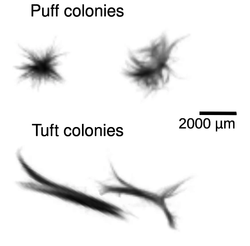Trichodesmium interact with bacteria to acquire iron from dust
Autor/Urheber:
Subhajit Basu, Martha Gledhill, Dirk de Beer, S. G. Prabhu Matondkar & Yeala Shaked
Attribution:
Das Bild ist mit 'Attribution Required' markiert, aber es wurden keine Informationen über die Attribution bereitgestellt. Vermutlich wurde bei Verwendung des MediaWiki-Templates für die CC-BY Lizenzen der Parameter für die Attribution weggelassen. Autoren und Urheber finden für die korrekte Verwendung der Templates hier ein Beispiel.
Shortlink:
Quelle:
Größe:
1745 x 919 Pixel (155906 Bytes)
Beschreibung:
Colonies of marine cyanobacteria Trichodesmium interact with associated bacteria to acquire iron from dust
Proposed dust-bound Fe acquisition pathway employed mutually by Trichodesmium colonies and associated bacteria. a The N2-fixing marine cyanobacterium Trichodesmium spp., which commonly occurs in tropical and sub-tropical waters, is of large environmental significance in fertilizing the ocean with important nutrients. b Trichodesmium can establish massive blooms in nutrient poor ocean regions with high dust deposition, partly due to their unique ability to capture dust, center it, and subsequently dissolve it. c The current study explores biotic interactions within Trichodesmium colonies that lead to enhanced dissolution and acquisition of iron from dust. Bacteria residing within the colonies produce siderophores (c-I) that react with the dust particles in the colony core and generate dissolved Fe (c-II). This dissolved Fe, complexed by siderophores, is then acquired by both Trichodesmium and its resident bacteria (c-III), resulting in a mutual benefit to both partners of the consortium
Proposed dust-bound Fe acquisition pathway employed mutually by Trichodesmium colonies and associated bacteria. a The N2-fixing marine cyanobacterium Trichodesmium spp., which commonly occurs in tropical and sub-tropical waters, is of large environmental significance in fertilizing the ocean with important nutrients. b Trichodesmium can establish massive blooms in nutrient poor ocean regions with high dust deposition, partly due to their unique ability to capture dust, center it, and subsequently dissolve it. c The current study explores biotic interactions within Trichodesmium colonies that lead to enhanced dissolution and acquisition of iron from dust. Bacteria residing within the colonies produce siderophores (c-I) that react with the dust particles in the colony core and generate dissolved Fe (c-II). This dissolved Fe, complexed by siderophores, is then acquired by both Trichodesmium and its resident bacteria (c-III), resulting in a mutual benefit to both partners of the consortium
Lizenz:
Credit:
Relevante Bilder
Relevante Artikel
TrichodesmiumTrichodesmium, englisch auch sea sawdust ‚Meersägemehl‘ genannt, ist eine Gattung fadenförmiger (filamentöser) Cyanobakterien. Man findet sie in nährstoffarmen tropischen und subtropischen Meeren. .. weiterlesen








